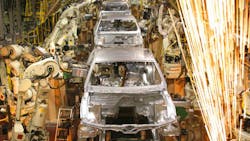After a brutal period of downsizing and reorganizing, the U.S. manufacturing sector has become the most competitive in the world.
Output per worker is higher than in any other major manufacturing country. Labor costs per unit of output are lower than in Brazil, Canada and Germany, and only slightly higher than in China. What’s more, writes Gregory Daco of Oxford Economics in the new report from which the above facts are taken, “the U.S. is ‘gifted’ with a stable regulatory framework, a flexible labor market, low energy costs and access to a large domestic market.” So that’s great! Time for a manufacturing renaissance, right?
Well, maybe.
Eventually.
But — and Daco notes this in his report — there are few signs of it actually happening yet. Yes, there are the almost 900,000 manufacturing jobs added in the U.S. since early 2010. But it’s important to see that for what it is — a modest rebound after a spectacular collapse.
There has also been a big decline in the trade deficit, from 5.6% of gross domestic product in 2006 to 3% in 2015. But that turns out to be a product of (1) an increase in the trade surplus in services and (2) the huge boom in domestic oil-production and accompanying fall in global oil prices. Strip out petroleum and petroleum products, in fact, and the trade deficit in goods is only down a little from its peak, and has grown markedly over the past two years.
This seems like a good spot to mention that running a trade deficit isn’t necessarily a bad thing. The growth in the deficit in 2014 and 2015 is due in part to the strength of the U.S. economy — faster growth than in other major economies and a strengthening dollar have led to more imports and fewer exports.
Still, you’d think that if there were a big return to manufacturing in the U.S. afoot — “reshoring” is the term of art — it would be making itself more apparent in the data. Consider, for example, trade in capital goods. While, the U.S. has been importing more cars and consumer goods than it exports for many decades, capital goods – airplanes, medical equipment, semiconductors and so on – have long been an area of comparative strength. Not so much anymore.
Again, one can find temporary factors increasing this deficit. The U.S. is usually a big net exporter of oil-drilling, mining and construction machinery, and recently demand for such equipment has plummeted (sorry, Caterpillar!). That demand will return someday, presumably.
There really aren’t many tangible signs, though, of a larger shift in manufacturing activity back to the U.S. The Boston Consulting Group, which has done as much as any organization to popularize the idea of reshoring manufacturing after years of offshoring to China and elsewhere, reported in December that a growing number of executives surveyed say they are moving production back to the U.S. from China or at least thinking about it. But rival consulting firm A.T. Kearney put out its own report in December asserting that “the reshoring phenomenon appears to have been more a one-off aberration than an inexorable trend.”
Why isn’t reshoring taking off? Daco, of Oxford Economics, stressed that such shifts don’t happen overnight. “It takes quite a bit of time for a company to modify its supply chain,” he said in a phone conversation. He also noted that “near-shoring” to Mexico, where unit labor costs are still substantially lower than in the U.S., remains popular.
A.T. Kearney, in its reshoring report, said that industries trying to avoid rising labor costs in China have been moving production to other Asian countries, not to the U.S. — and that that’s probably not going to change soon: The countries of South and Southeast Asia — even after India is taken out of the equation — have labor forces that run into the hundreds of millions of workers, so the gradual shift of certain industries to other Asian low-cost countries is likely to continue.
This explains why clothing- and furniture-making, for example, are unlikely to return to the U.S. in a big way. But in capital-goods manufacturing, labor costs matter less than technology and the existence of a local ecosystem of suppliers, consultants and skilled workers that can take a while to put together. In their rush to offshore, then, U.S. manufacturers may have permanently destroyed their ability to make certain products here.
As Gary P. Pisano and Willy C. Shih wrote in a 2009 Harvard Business Review article: In making their decisions to outsource, executives were heeding the advice du jour of business gurus and Wall Street: Focus on your core competencies, off-load your low-value-added activities, and redeploy the savings to innovation, the true source of your competitive advantage. But in reality, the outsourcing has not stopped with low-value tasks like simple assembly or circuit-board stuffing. Sophisticated engineering and manufacturing capabilities that underpin innovation in a wide range of products have been rapidly leaving too. As a result, the U.S. has lost or is in the process of losing the knowledge, skilled people, and supplier infrastructure needed to manufacture many of the cutting-edge products it invented.
This loss of capability could be what we’re seeing evidence of in the trade data. If so, a true U.S. manufacturing renaissance may be a long time coming.
By Justin Fox
